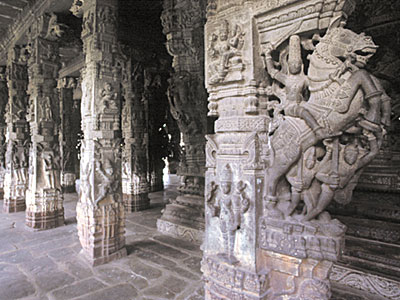 The architecture of Sri Varadaraja Perumal Temple is wonderful. Even the sculptural works of the temple are a treat for the eyes of an onlooker. The Vijayanagara rulers had paid attention to every little detail of the temple in order to make the temple a spectacle.
The architecture of Sri Varadaraja Perumal Temple is wonderful. Even the sculptural works of the temple are a treat for the eyes of an onlooker. The Vijayanagara rulers had paid attention to every little detail of the temple in order to make the temple a spectacle.
The Vijayanagar kings constructed the temple and the grand gopurams on the east and the west which are architectural marvels. There are five prakasamas around the temple, with high outer compound walls. The whole temple covers an area of about on acres. Probably this is the largest area covered by a temple. Within the first prakaram there is a hundred-pilar mandapam built in the 16th century A.D. by the Vijayanagar kings. The sculptural beauty of the pillars is amazing. Ornamental rings carved out of single stone at the four corners of the mandapam in the form of a chain are a delightful spectacle. All the pillars contain marvellous specimens of Vijayanagar art from top to bottom. There are carvings depicting different legends from Hindu mythology and forms of dancing damsels in various poses. The cavalcade of marching soldiers, the baffling and intricate physical feats as shown in a circus by a number of men and women and monkeys are vivid portrayals of the socio-physical culture of the time.
The sculptors of the temple were past masters in depicting life like figures with their crude chisel on black granite. The scenes remain as sharp as when they came out of the sculptor`s dexterous hands and still remain a marvel to the sightseers` even centuries after. In fact it may even be called the Museum of Vijayanagara Art and Sculpture.
The Dhwajastambha of the temple is over 100 feet in height. It is made of a single stone. The Ananta Teertham, a holy tank is on the north of the 100 pillar mandalam. There are two mandalams in the tank one for Lord Sri Aritigiri and another called the Neerali Mandalam. Lord Sri Aritigiri Varadaraja is lying below the water and is taken out once in a generation for the worship of devotees.
A beautiful garden is inside the prakaramas where the shrines of Azhwars have been installed. Sri Perundevi Tayar the consort of Lord Varadaraja, pays a visit to this graden every Friday, when a festival is celebrated. It is said that Sri Perundevi Tayar had her manifestation in a holy tank near the eastern tower. The shrine of this Tayar is on a small hillock. On entering the Hastagiri Hill one is able to notice in Sri Guha Narsimha`s shrine, Lord Sri Alagaisngar and Sri Haritartha Devi.
Thus, it can be concluded saying that the architecture of Sri Varadarja Perumal Temple is an absolute wonder with all its features.











